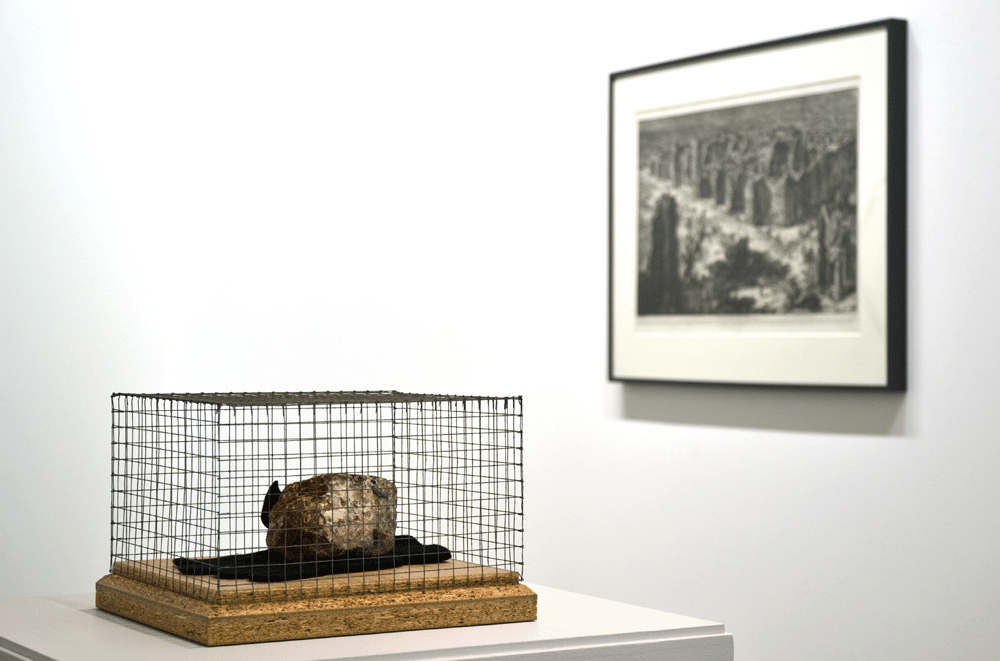Over Your Cities Grass Will Grow
Hidde van Seggelen Gallery
Hidde van Seggelen Gallery

There are two pitfalls of living in large cities like London: on the one hand, it’s a little too easy to dream of escaping the metropolis while tilling an allotment and buying Rainforest Crisp breakfast cereal; on the other hand, it’s hard to resist the allure of the city as the playground of endless possibilities and transformation, a place of magic and adventure. Perhaps this is why the group show ‘Over Your Cities Grass Will Grow’, organized by Dutch curator Ardi Poels, struck a sort of warbling, uncertain, but still resonant chord, in that its confusion and inconsistencies reflected these same conflicting desires. Ostensibly dealing with Romantic visions and imaginings of the city, the exhibition took as its starting point Giovanni Battista Piranesi’s Rovine delle Terme di Antoniniane (Ruins of the Baths of Antonius, 1800–07), an architectural etching of overgrown ruins that provides a direct illustration of the prediction of the exhibition’s title.
‘Over Your Cities Grass Will Grow’ comes from a passage in the Book of Isaiah which describes the ‘Lord’s day of vengeance’. Of course, with eco-friendly methods of insulation being used today, grass growing over our cities is more encouraged than feared, but the sense of threat originally intended found itself translated here into something more like ‘Your City Will Devour You’. Entering the gallery, you were immediately put under intense surveillance: on one wall, seven eyes – human, alligator, goat and who knows what else – stared out from the thick clay mud-coloured glass surface of Thomas Grünfeld’s Untitled (egg-shaped/ocre) (2005); on the opposite wall, the bulging mirrored hemisphere of Suchan Kinoshita’s Dutch Disco (2010) was an imposing eye that absorbs the entire room. The transparent iris of the eye revealed a disco ball turning inside that only increased the sense of creepy unease. Nearby, Ciprian Mure˛san’s Untitled (Shopping Cart) (2010) comprised a shopping trolley filled with hundreds of books, which on closer inspection were different translations of The Castle (1926), Franz Kafka’s unfinished tale of labyrinthine bureaucracy and absolute authority. The contemporary apocalypse, it seems, is being hemmed in on all sides by the CCTV’d walls of the city.
A few means of escaping this, or at least looking at things from a different angle, were also on offer. Gregor Schneider suggests simply burrowing even further into the urban space: accompanying the exhibition was a dense film programme, which included his Haus Video (1996), a shaky handheld tour of the improbable rooms-within-rooms and burrowed tunnels dissecting an apparently normal German household. Ann Veronica Janssens provided a touch of magical realism, a light dusting of glitter topping the hefty concrete bricks lining the floor of Untitled (Anvers) (2010). While hers is an escapist poetry, making ethereal beauty from stern urban surroundings, the curator Poels also included works by Stanley Brouwn and Pieter Laurens Mol as examples of more prosaic, literally pedestrian means of claiming the city.
But attempting to walk the uneasy trail between looking at our urge to reconnect with nature in urban space and attempts to recast urban spaces as a re-imagining or replacement of nature, ‘Over Your Cities...’ nonchalantly raised a slew of issues but left them to fester on the wayside. The show’s condensed form felt scattered and schizophrenic; it easily could (and should) have been larger and more expansive. It felt as if the show was providing a more potent, abstract angle on the practical and literal take on nature in the Barbican’s 2009 ‘Radical Nature’ exhibition, but at same time tacking on a romantic conceptualist stance as some sort of solution of those issues. The inclusion of Mol’s found assemblage and Brouwn’s personalized foot measurements, along with Bas Jan Ader’s ‘Fall’ series (1970–1) in the video programme, felt out of place, as a not unrelated but certainly separate set of arguments reflecting on how individuals move in their environment. There was also some attempt to gesture towards our mutual construction of both urban and natural spaces, but this was done quite heavy-handedly through pieces like Hans Op de Beeck’s cute music video Staging Silence (2009). Ultimately, ‘Over Your Cities...’ was a dense dream of a wander through the remains of a wrecked city; latent with potential, but still a mess.
























